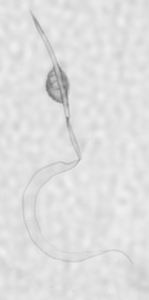Scientists at the Smithsonian Institution and partners have published a paper that optimizes sperm collection protocols from the critically endangered Panamanian Golden Frog Atelopus zeteki. It also improves our understanding of reproduction in endangered harlequin frogs. The research, to be published published 15 March 2017, in Theriogenology, was conducted by Dr. Gina DellaTogna, a Panamanian biologist who studied this charismatic animal at the National Zoological Park in Washington DC. The study characterizes the dose-response patterns for several artificial hormone treatments and describes the sperm morphology for the first time in this species.
“This study is important, because it contributes towards the basic understanding of reproduction of a highly endangered group of frogs in Latin America,” said DellaTogna, who performed the experiments for her PhD at the University of Maryland. “This study has already helped us to solve critical reproduction problems in captive Atelopus collections in Panama and allowed us to repeatedly collect high-quality sperm samples for genome resource banking at any time of the year, without harming the frogs.”
“Basic reproductive research is something that has yielded huge conservation dividends for the successful care and management of other endangered species like Pandas and Black Footed Ferrets,” said Pierre Comizzoli, a co-author of the paper and reproduction specialist at the National Zoo. “Gina’s research opens the door to develop methods like sperm freezing and storage to preserve the long term genetic integrity and diversity in small populations.”
The research is particularly relevant to current amphibian conservation efforts in Panama where the Panama Amphibian Rescue and Conservation Project has captive-breeding colonies of five species of Atelopus that are threatened with extinction from the deadly fungal disease chytridiomycosis.

Roberto Ibáñez, and Gina DellaTogna working on hormonal stimulation of frogs at the Panama Amphibian Rescue and Conservation Project
“Successful reproduction is key to any captive assurance program,” said Roberto Ibáñez, the director of the Panama Amphibian Rescue and Conservation project at the Smithsonian Tropical Research Institute in Panama. “Gina has already begun applying what she has learned to successfully help us to produce offspring from four other endangered harlequin frog species. I hope that she will eventually extend it to species with different modes of reproduction that are also difficult to breed”.
The research was made possible with assistance from the Maryland Zoo in Baltimore who manage the Golden Frog Species Survival Plan. Funding was provided from the Panamanian Government’s Secretaría Nacional de Ciencia y Tecnología (SENACYT), The WoodTiger Fund, the Smithsonian Endowment for Science and the University of Ottawa Research Chairs Program.
Della Togna G, Trudeau VL, Gratwicke B, Evans M, Augustine L, Chia H, Bronikowski EJ, Murphy JB, Comizzoli P. 2017 Effects of hormonal stimulation on the concentration and quality of excreted spermatozoa in the critically endangered Panamanian golden frog (Atelopus zeteki). Theriogenology. http://dx.doi.org/10.1016/j.theriogenology.2016.12.033

